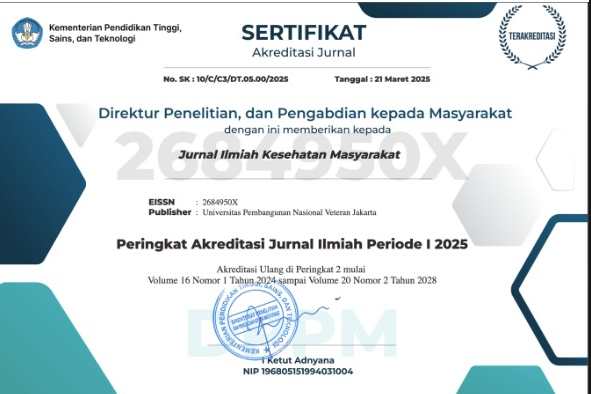Feasibility of The Special Index for Handling Stunting (IKPS) as an Indicator of Government Performance in Stunting Management in Indonesia
Abstract
Background: Stunting is a crucial issue in the 2024-2029 presidential election, as its resolution is key to achieving a Golden Indonesia vision by 2045. Addressing stunting has become a primary agenda for the Indonesian government, as outlined in the 2020-2024 National Medium-Term Development Plan. The President has instructedStatistics Indonesia to develop a measurement for stunting, namely IKPS. No studies have evaluated the suitability of IKPS as a performance measurement tool. This study aimed to assess the feasibility of IKPS as a government performance indicator in addressing stunting in Indonesia.
Method: This Cross-sectional study utilized secondary data from IKPS. Stunting prevalence data for 2018 and
2019 were sourced from the combined Indonesian Toddler Nutritional Status Study and the 2019 National
Socioeconomic Survey. Data analysis included descriptive statistics, correlation tests, simple regression analysis,
and quadrant analysis to measure relationships and effects between the variables.
Result: No significant relationship was found between IKPS and stunting prevalence (r=-0.092, p-value=0.593),
though a strong and significant correlation was observed between changes in IKPS and stunting prevalence (r=-
0.467, p=0.005).
Conclusion: The relationship pattern was unexpected, showing a negative linear association in which increased
IKPS did not effectively reduce stunting prevalence. These findings highlight the need for a valid IKPS for program planning, evaluation, and decision-making and suggest further research on IKPS construction methodology.
References
Gatti R V., Corral Rodas PA, Dehnen NAP, Dsouza R, Mejalenko JE, Pennings SM. The Human Capital Index2020 Update [Internet]. The
Human Capital Index 2020 Updat Washington, D.C: The World Bank; 2020 Sep. Available from: http://documents.worldbank.org/curated/en/456901600111156873/The-Human-Capital-Index-2020-Update-Human-Capital-in-the-Time-of-COVID-19
Kementerian Koordinator Bidang Pembangunan Manusia dan Kebudayaan. Capai Indonesia Emas, Tangani Stunting dan Kemiskinan Ekstrem [Internet]. [cited 2023 May 8]. Available from: https://www.kemenkopmk.go.id/capai-indonesia-emas-tangani-stunting-dan-kemiskinan-ekstrem
Dewey KG, Begum K. Long-term consequences of stunting in early life. Matern Child Nutr. 2011 Oct;7(SUPPL. 3):5–18.
Osendarp S, Akuoku JK, Black RE, Headey D, Ruel M, Scott N, et al. The COVID-19 crisis will exacerbate maternal and child undernutrition and child mortality in low- and middle-income countries. Nat Food [Internet]. 2021 [cited 2022 May 28];2(7):476–84. Available from: https://remote-lib.ui.ac.id:2120/record/display.uri?eid=2-s2.0-85110784583&origin=reflist&sort=lfp-t&src=s&st1=Geographic+and+Socioeconomic+Disparity+in+Child+Undernutrition+across+514+Districts+in+Indonesia&sid=ddf0436ff9c5aaddd3da594c6edafb2b&sot=b&sdt=
Sari N, Manjorang MY, Zakiyah, Randell M. Exclusive breastfeeding history risk factor associated with stunting of children aged 12–23 months. Kesmas J Kesehat Masy Nas (National Public Heal Journal). 2021;16(1):28–32.
United Nations. Goal 2: Zero Hunger - United Nations Sustainable Development [Internet]. Goal 2: Zero Hunger. [cited 2023 May 8]. Available from: https://www.un.org/sustainabledevelopment/hunger/
World Health Organization. Global Nutrition Targets 2025: Stunting Policy Brief (No. WHO/NMH/NHD/14.3) [Internet]. World Health Organization. [cited 2023 May 8]. Available from: https://www.who.int/publications/i/item/WHO-NMH-NHD-14.3
Kementerian Kesehatan. Studi Status Gizi Indonesia 2021. Vol. 2. 2021.
Rizal MF, van Doorslaer E. Explaining the fall of socioeconomic inequality in childhood stunting in Indonesia. SSM - Popul Heal. 2019 Dec 1;9.
Biro Pusat Statistik Republik Indonesia. Laporan Indeks Khusus Penanganan Stunting (IKPS) tahun 2020. Badan Pusat Statistik, Jakarta - Indonesia. 2020.
BPS. Laporan Indeks Khusus Penanganan Stunting 2019-2020 [Internet]. Badan Pusat Statistik. 2021. 1–63 p. Available from: https://www.bps.go.id/publication/2021/09/08/3b622d713a80363685aef508/laporan-indeks-khusus-penanganan-stunting-2019-2020.html
Haryono K, Presiden SW, Negara S, Oktoviani I, Presiden SW. Policy brief pemanfaatan ikps dalam pengambilan kebijakan percepatan penurunan stunting [Internet]. 2023 [cited 2023 Feb 20]. Available from: https://www.wapresri.go.id/policy-brief-pemanfaatan-ikps-dalam-pengambilan-kebijakan-percepatan-penurunan-stunting/
Krisnawati T. Penanganan Stunting Sebelum dan Sesudah Pandemi COVID-19 di Provinsi Bali. E-Jurnal Med Udayana [Internet]. 2021 [cited 2023 Feb 13];10(10):1–7. Available from: https://pesquisa.bvsalud.org/global-literature-on-novel-coronavirus-2019-ncov/resource/pt/covidwho-1645432%0Ahttps://ojs.unud.ac.id/index.php/eum/article/view/77740
Muhafidin D. Policy strategies to reduce the social impact of stunting during the COVID-19 pandemic in Indonesia. J Soc Stud Educ Res [Internet]. 2022 [cited 2023 Feb 13];13(2):320–42. Available from: http://jsser.org/index.php/jsser/article/view/4238
Suraya GR, Wijayanto AW. Comparison of Hierarchical Clustering, K-Means, K-Medoids, and Fuzzy C-Means Methods in Grouping Provinces in Indonesia according to the Special Index for Handling Stunting. Indones J Stat Its Appl [Internet]. 2022 [cited
Feb 13];6(2):180–201. Available from: https://www.stat.ipb.ac.id/journals/index.php/ijsa/article/view/899
Bachtiar N. Benarkah Pemberian ASI Dapat Menekan Ancaman Stunting? J Kebijak Kesehat Indones JKKI [Internet]. 2019;8(4):184–90. Available from: https://jurnal.ugm.ac.id/jkki/article/view/51266
Kusrini I, Supadmi S, Mulyantoro DK, Laksono AD, L Tobing K. Validity and reliability of the GHI-SN as an alternative indicator to describe health inequities among children under five in Indonesia’s sub-national level. Pakistan J Med Heal Sci [Internet]. 2021 [cited 2023 Feb 13];15(8):2314–8. Available from: https://pjmhsonline.com/2021/august/2314.pdf
Kemenkes RI. Laporan Pelaksanaan Integrasi Susenas Maret 2019 dan SSGBI Tahun 2019 [Internet]. Badan Pusat Statistik, Jakarta - Indonesia. 2019. Available from: https://stunting.go.id/?smd_process_download=1&download_id=5219
Permatasari TAE, Chairunnisa C, Djarir H, Herlina L, Fauziah M, Andriyani A, et al. The Determinants of Stunting in the Under-five in Three Municipalities in the Special Capital Region of Jakarta. Kesmas J Kesehat Masy Nas (National Public Heal Journal). 2023;18(1):32.
Heidkamp RA, Piwoz E, Gillespie S, Keats EC, D’Alimonte MR, Menon P, et al. Mobilising evidence, data, and resources to achieve global maternal and child undernutrition targets and the Sustainable Development Goals: an agenda for action. Lancet [Internet]. 2021;397(10282):1400–18. Available from: http://dx.doi.org/10.1016/S0140-6736(21)00568-7
Hayuningtyas W, Wibawa AD. The Change of Socio-Economic Correlation due to COVID-19 Pandemic in Indonesia. 2021 Int Conf Data Sci Its Appl ICoDSA 2021. 2021;221–7.
Suárez E, Pérez CM, Rivera R, Martínez MN. Applications of Regression Models in Epidemiology [Internet]. Applications of Regression Models in Epidemiology. 2017 [cited 2023 Apr 27]. Available from: https://www.proquest.com/docview/2131007785/3D352F769E664C65PQ/20?accountid=17242
Wicaksono F, Harsanti T. Determinants of stunted children in Indonesia: A multilevelanalysis at the individual, household, and community levels. Kesmas Natl Public Heal J. 2020;15(1):48–53.
Lauro NC, Grassia MG, Cataldo R. Model Based Composite Indicators: New Developments in Partial Least Squares-Path Modeling for the Building of Different Types of Composite Indicators. Soc Indic Res. 2018 Jan 1;135(2):421–55.
Nardo M, Saisana M, Tarantola A, Stefano S. Tools for Composite Indicators Building [Internet]. 2005. Available from: http://collection.europarchive.org/dnb/20070702132253/http://farmweb.jrc.ec.europa.eu/ci/Document/EUR 21682 EN.pdf
Nardo M, Saisana M, Saltelli A, Tarantola S, Hoffmann A G. Handbook on Constructing Composite Indicators: Methodology and User Guide [Internet]. Handbook on Constructing Composite Indicators: Methodology and User Guide. Paris (France): OECD; 2008. Available from: http://213.253.134.43/oecd/pdfs/browseit/3008251E.PDF
TP2S Setwapres. Hasil Perhitungan IKPS Nasional dan Provinsi tahun 2022 [Internet]. 2023 [cited 2024 Oct 25]. Available from: https://stunting.go.id/hasil-perhitungan-ikps-nasional-dan-provinsi-tahun-2022/
Beal T, Tumilowicz A, Sutrisna A, Izwardy D, Neufeld LM. A review of child stunting determinants in Indonesia. Vol. 14, Maternal and Child Nutrition. Blackwell Publishing Ltd; 2018.
Ramesh M, Howlett MP, Wu X. Rethinking Governance Capacity As Organizational and Systemic Resources. SSRN Electron J. 2016 Jul 6;
Terzi S, Otoiu A, Grimaccia E, Mazziotta M, Pareto A. Open issues in composite indicators: A starting point and a reference on some state-of-the-art
issues [Internet]. 2021 [cited 2023 Jan 25]. 5–7 p. Available from: https://books.google.com.pe/books?id=KbwgEAAAQBAJ&printsec=frontcover&hl=es#v=onepage&q&f=true
GHI GHI. Global Hunger Index 2022 : Malaysia [Internet]. Global Hunger Index. 2022 [cited 2023 May 6]. Available from: www.globalhungerindex.org
Greco S, Ishizaka A, Tasiou M, Torrisi G. On the Methodological Framework of Composite Indices: A Review of the Issues of Weighting, Aggregation, and Robustness. Soc Indic Res [Internet]. 2019 Jan 15 [cited 2022 Dec 22];141(1):61–94. Available from: https://link.springer.com/article/10.1007/s11205-017-1832-9
Bhutta ZA, Akseer N, Keats EC, Vaivada T, Baker S, Horton SE, et al. How countries can reduce child stunting at scale: Lessons from exemplar countries. Am J Clin Nutr. 2020;112:894S-904S.
Smith LC, Haddad L. Reducing Child Undernutrition: Past Drivers and Priorities for the Post-MDG Era. World Dev [Internet]. 2015;68(1):180–204. Available from: http://dx.doi.org/10.1016/j.worlddev.2014.11.014
Eryando T, Sipahutar T, Budhiharsana MP, Siregar KN, Aidi MN, Utari DM, et al. Spatial analysis of stunting determinants in 514 Indonesian districts/cities: Implications for intervention and setting of priority. Geospat Health. 2022;17.
Gisselquist RM. Developing and evaluating governance indexes: 10 questions. Policy Stud [Internet]. 2014 Sep 3 [cited 2022 Dec 22];35(5):513–31. Available from: https://remote-lib.ui.ac.id:2216/doi/abs/10.1080/01442872.2014.946484
Bonnet J, Coll-Martínez E, Renou-Maissant P. Evaluating sustainable development by composite index: Evidence from french departments. Sustain. 2021;13(2):1–23.
welt hunger hilfe, Concern worldwide. Global hunger index: Food systems transformation and local governance [Internet]. Welthungerhilfe and Concern Worldwide. Bonn/Dublin; 2022. p. 1–60. Available from: https://www.globalhungerindex.org/pdf/en/2022.pdf
Cavicchia C, Vichi M. Statistical Model-Based Composite Indicators for Tracking Coherent Policy Conclusions. Soc Indic Res [Internet]. 2021 [cited 2023 Jan 25];156(2–3):449–79. Available from: https://doi.org/10.1007/s11205-020-02318-7
Hossain M, Choudhury N, Abdullah KAB, Mondal P, Jackson AA, Walson J, et al. Evidence-based approaches to childhood stunting in low and middle income countries: A systematic review. Arch Dis Child. 2017 Oct 1;102(10):903–9.
Mutiari KA, Kuntoro K. Quadrant Analysis of Total Fertility Rate and Contraceptive Prevalence Rate of District and City in East Java. J Biometrika dan Kependud. 2020;9(2):87.
cegah stunting. Briefing Tim Nutrition for Growth (N4G) Indonesia 2021 – Cegah Stunting [Internet]. [cited 2023 May 8]. Available from: https://cegahstunting.id/berita/briefing-tim-nutrition-for-growth-n4g-indonesia-2021/









.jpg)








